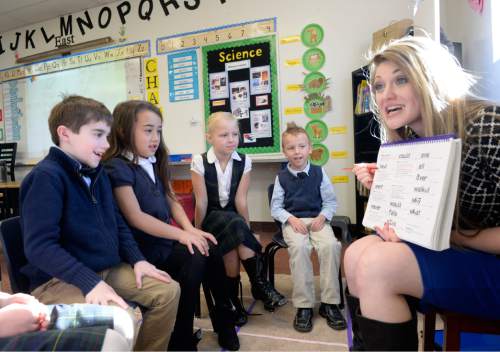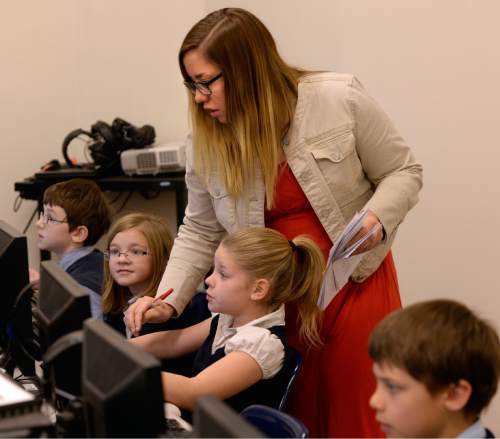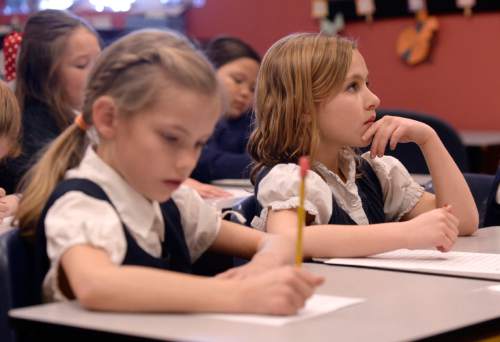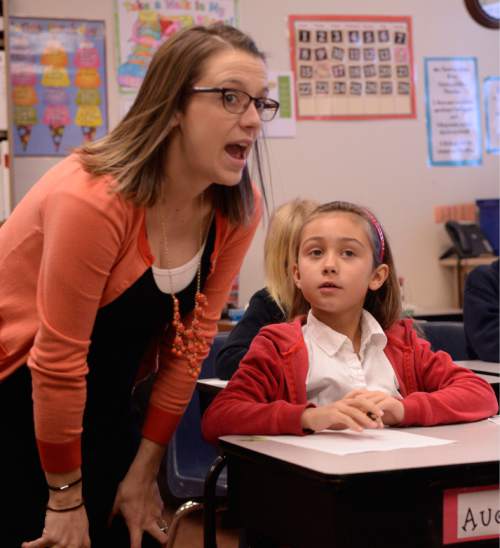This is an archived article that was published on sltrib.com in 2015, and information in the article may be outdated. It is provided only for personal research purposes and may not be reprinted.
When Joseph Kim enrolled his sons at City Academy two years ago, he was lured by the appeal of small class sizes and individualized instruction.
But in November, dissatisfied with teacher turnover, lax student discipline and low test scores, Kim pulled ninth-grader Peter and eighth-grader James out of the Salt Lake City charter school.
"Smaller schools can have advantages, but in this case, it was a big disadvantage," Kim said. "That's a school with a problem."
Peter and James now attend Evergreen Junior High, a traditional public school. But because they left City Academy in November, after fall enrollment numbers were calculated, their share of state per-pupil funding didn't necessarily follow them back to the Granite School District.
While traditional school funding is based on average enrollment, which rises and dips during the year, charter school funding is based on a snapshot taken annually Oct. 1.
In the current school year, more than 400 students have returned to Granite School District from charter schools since the October head count, according to district spokesman Ben Horsley. That exodus equates to roughly $1.2 million in per-pupil revenue that students left behind at their former schools.
Enrollment is just one thread in the tangled web of Utah's charter-school funding process, which uses a complex blend of accounting formulas that state Superintendent Brad Smith recently described as a "huge goiter on the body politic."
And with one out of every 10 public school students now attending a charter school, educators, lawmakers and policymakers are looking at how best to provide — and pay for — a quality education for every child.
"That may mean we really have to go back to the drawing board," Smith said. "The whole funding structure is fundamentally not sound."
—
Show them the money • State funding for education is supplemented at the local level by property taxes. But unlike school districts, which can raise taxes to meet increased needs, charter schools do not have taxing authority.
Instead, school districts are required to set aside a portion of their local property taxes, which is then combined with state funding and distributed to charter schools.
That revenue sharing, known as local replacement funding, is a perennial source of frustration for district administrators, who object to handing over already-scant public money to unelected charter school leaders.
"We have no way to ensure to the public that the money is being spent right," said Jordan Board of Education President Susan Pulsipher.
Charter advocates, conversely, argue that the local property taxes parents pay should follow their children to whatever schools they attend.
"The public school that I choose to send my kids to, my tax dollars should follow," said Kim Frank, executive director of the Utah Charter Network.
This year, lawmakers strained tensions between advocates for traditional public schools and nontraditional charters further by recommending that districts contribute a greater share of local revenue to charters.
Because the funding shift was adopted during budget talks, Gov. Gary Herbert symbolically opposed the policy change by allowing the public education base budget to become law without his signature last week.
"While the governor understands the need to have a base budget in place," Herbert's spokesman Marty Carpenter said, "he is unwilling to add his signature to a bill that needlessly cuts education funding and makes a significant policy change that has not been sufficiently debated."
Many educators, including the Jordan Board of Education in a letter to lawmakers, responded to the revenue-sharing increase by renewing calls for charter school funding to be listed on property tax disclosure statements. If charters are to receive district money, they argue, then taxpayers should be aware of how big the check is.
"Our district and our board want charters to get their fair share and we want it to be equitable," Pulsipher said. "It's just that we need to have accountability and transparency."
Jordan School District contributes $2.6 million to charter school funding, Pulsipher said. While that figure is a relatively small percentage of the district's total budget, she said, it's a substantial sum to hand over to school officials who don't answer to voters.
"It's an amount that I think would be helpful for people to understand where it's going," she said.
Charter advocates are resistant to the idea of listing charter schools on property tax notices.
The Charter Network's Frank argues that charter school boards are accountable to voters, albeit in a different way. If parents didn't enroll their children, she said, charter schools would be forced to close.
"Those parents are voting with their feet," Frank said. "They can leave any day of the week if they choose to."
And Royce Van Tassell, executive director of the Utah Association of Public Charter Schools, said including a charter school line item on tax statements could be more confusing than transparent. By listing charters next to taxing authorities, he says, taxpayers might get the impression that the alternative public schools are imposing taxes.
"The property tax notice never describes to anyone how the dollars are spent."
But Sen. Howard Stephenson, R-Draper, who also works as president of the Utah Taxpayers Association, says tax notice transparency wouldn't necessarily be a bad thing. It could be informative for taxpayers to know how much of their property tax is going toward charter school funding.
"The more transparency," he said, "the better."
—
A statewide tax? • Others argue the solution to charter school funding is severing all ties with school district revenue.
Rep. Kraig Powell, R-Heber City, is working on a bill that would eliminate local replacement funding in favor of a statewide property tax for charter schools.
"We're going to eternally argue about that," he said. "So my solution is: Let's solve the whole thing by giving charter schools and their students their own property tax."
Similar proposals have been considered and defeated at the Legislature, but Powell said the growing numbers of charter schools — and the budgetary gymnastics required to fund them — are prompting lawmakers to take a second look at other options.
"We've gotten to the point," he said, "where we're fighting over such large amounts of money."
Frank said the state isn't ready for a charter school tax.
"That idea has been on the table for at least 10 or 12 years," she said. "It's never going to pass."
She said the Utah Charter Network and other charter advocates aren't opposed to a statewide tax, as long as all students are funded equitably.
"The districts would be thrilled if there was a statewide property tax," she said, "and I think, for the most part, the charters wouldn't care."
Stephenson said a separate property tax raises a number of questions about administration and distribution, but could potentially create a "win-win" for districts and charter schools.
"We don't need to increase taxes," he said. "But if it's to bifurcate the local [tax] levy, I think that would be informative to voters."
Van Tassell said there are larger questions related to funding than whether it comes from school districts or a statewide tax. He said the entire education system — districts and charters — needs to be re-evaluated so a school is rewarded for achievement, rather than the number of students entering its doors.
"The systems," he said, "are designed to reward how long a child is in a seat."
—
Ins and outs, ups and downs • With the clock ticking down to the March 12 end of the legislative session, lawmakers have discussed creating a task force to study charter school funding, including the local replacement system and various formulas for calculating enrollment numbers.
The Oct. 1 snapshot method for determining enrollment was scheduled to sunset this year, but lawmakers recommended extending that deadline to mitigate roughly $5.6 million in funding that charter schools would lose by switching to a uniform calculation.
While that shortfall would suggest charters are benefiting from students who transfer, like Peter and James Kim, Associate State Superintendent Bruce Williams said the rumors of annual November student purges at the nontraditional public schools are exaggerated.
Because most charters have waiting lists, an exiting student often is replaced with a new enrollee during the year, he said. And Utah's charter school populations tend to be internally fluid, moving from charter to charter, but not necessarily returning to traditional schools.
"They may be leaving," he said, "but they may not be going to district schools."
The state does not track which schools students transfer into and out of during the year. Overall, 8 percent of students switched schools during the 2013-2014 school year, according to the Utah Office of Education — about 50,000 kids.
Sonia Woodbury, director of City Academy, said she has never felt incentivized to juke her stats by purging students in November or December.
"If I don't care about that and people keep leaving during a school year," she said, "then my enrollment next fall is not going to be very good."
Frank said the current system, with all its quirks, results in winners and losers among charters and district schools.
She said improvement is possible, but Utah has not yet reached a point where a mass overhaul of the funding mechanism is needed.
"The conversation is worth having," she said. "I'm not sure that we've reached what we would call a saturation point."
In an ideal scenario, Frank said, every Utah public school student would be funded at a uniform level, independent of school or ZIP code.
It's a difficult tax framework to achieve, because local voters get to choose whether to raise their property taxes to invest in schools.
And, Frank said, the areas that most need additional revenue often are the least able to raise it.
"There are a lot of districts that really can't raise taxes on their families any more than they already have," she said. "A Tintic student deserves the same education a Park City student gets."

























